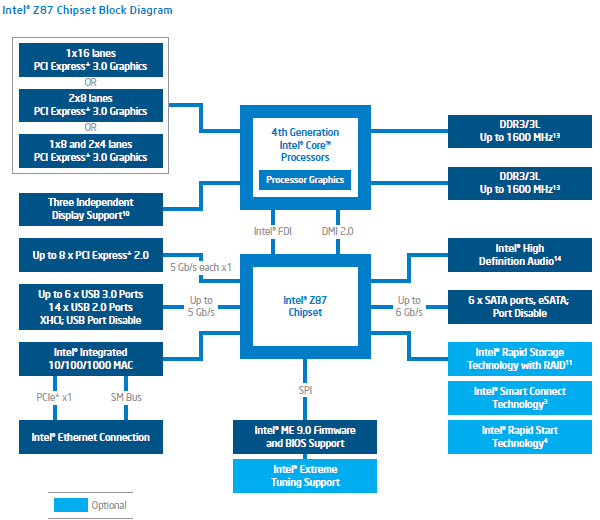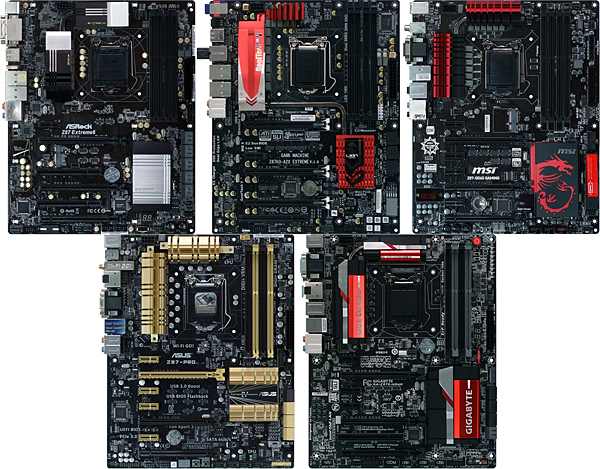Five Z87 Motherboards Under $220, Reviewed
Intel’s Haswell architecture displaces Ivy Bridge in its desktop line-up, bringing with it yet another new CPU interface. We tested six motherboards that claimed to be ready for your overclocking efforts, and included the five survivors in today’s review.
Haswell: Is Now The Best Time To Build?
Why you can trust Tom's Hardware
There's hardly a bad time to upgrade an old, slow PC. We only get skittish a few days before and a few days after a major technology launch, when vendors start jockeying for position with their prices and the newest stuff might end up pricier than where it'll eventually settle. Intel tends to replace the products in its stack with comparably-priced offerings, though. So, any level of improvement, no matter how small, could (and probably should) make Haswell-based processors better values than the outgoing models built on the Ivy Bridge architecture.
In case you missed it, we reviewed the flagship desktop CPU in The Core i7-4770K Review: Haswell Is Faster; Desktop Enthusiasts Yawn. The title makes it pretty clear: Chris wasn't particularly impressed with the incremental improvements Haswell brings to the desktop space, acknowledging that this architecture has bigger aspirations in mobility. If you already own a Core i7-3770K, there's probably little reason to upgrade. If you made an investment in Sandy Bridge-E, again, there's probably little reason to upgrade. But if your machine employs a Core i7-2700K or older, it might be time to start thinking about something new.
Fortunately, Intel's 8-series platform controller hubs give us platform-oriented guys something to get excited about. Intel got rid of the Z77’s four SATA 3Gb/s ports in favor of additional SATA 6Gb/s connectivity, creating a more SSD-friendly storage foundation. The company also increased USB 3.0 port count by 50%, again bringing the total to six. And with only one generation of processors to support, Intel was able to guarantee the ability to split the on-die PCI Express 3.0 controller's 16 lanes into two x8 links, or a x8 and two x4 slots. Surely that's big news for anyone who read The GeForce GTX 770 Review: Calling In A Hit On Radeon HD 7970? and is considering three 770s for less than the price of two 780s.
That’s not to say the new chipset is perfect. Its ancient DMI 2.0 interface still limits us to the bandwidth of four USB 3.0 ports. Or four-lane PCIe 2.0 devices. Or barely more than three SATA 6Gb/s drives. Intel gets away calling this its top-end mainstream solution only because we've grown to expect fairly little from south bridges.
Well-informed readers might even point out that this is the same DMI interface used in Intel’s last two platforms, and Intel’s own documents confirm that Z87 Express can be used with its older LGA 1155 interface. But you probably aren't going to see many Z87-based boards with last generation's socket because motherboard manufacturers know that intermediate parts confuse the market. We’ve been there and written about that. It appears that power pin assignments for the new architecture, which employs integrated voltage regulation, were the only snag that required Intel to adopt yet another interface.
| LGA 1150 ATX Motherboard Features | |||||
|---|---|---|---|---|---|
| Row 0 - Cell 0 | ASRock Z87 Extreme6 | Asus Z87 Pro | ECS Z87H3-A2X Extreme | Gigabyte Z87X-UD4H | MSI Z87-GD65 Gaming |
| PCB Revision | 1.06 | 1.02 | 1.0 | 1.0 | 1.1 |
| Chipset | Intel Z87 Express | Intel Z87 Express | Intel Z87 Express | Intel Z87 Express | Intel Z87 Express |
| Voltage Regulator | 12 Phases | 12 Phases | 12 Phases | 16 Phases | 12 Phases |
| BIOS | M1.21D (05/17/2013) | 1007 (05/17/2013) | 30514 (5/14/2013) | F5 (05/16/2013) | V1.1 (04/26/2013) |
| 100.0 MHz BCLK | 99.97 (-0.03%) | 99.94 (-0.06%) | 99.77 (-0.23%) | 99.77 (-0.23%) | 100.01 (+0.01%) |
| I/O Panel Connectors | |||||
| P/S 2 | 1 | 1 | None | 1 | 1 |
| USB 3.0 | 4 | 6 | 6 | 6 | 4 |
| USB 2.0 | 2 | None | 2 | None | 2 |
| Network | 2 | 1 | 2 | 1 | 1 |
| eSATA | 1 (Shared w/SATA) | 1 | 2 | 2 (Shared w/SATA) | None |
| CLR_CMOS Button | Yes | No | Yes | No | Yes |
| Digital Audio Out | Optical | Optical | Optical | Optical | Optical + Coaxial |
| Digital Audio In | None | None | None | None | None |
| Analog Audio | 5 | 6 | 5 | 6 | 6 |
| Video Out | DVI-I, DisplayPort, HDMI | HDMI, DisplayPort, VGA, DVI-D | DisplayPort, HDMI | VGA, DVI-I, HDMI, DisplayPort | VGA, DVI-I, HDMI |
| Other Devices | HDMI-In (Pass-through) | 802.11n / Bluetooth Combo | 802.11n, Bluetooth | None | None |
| Internal Interfaces | |||||
| PCIe 3.0 x16 | 3 (x16/x0/x0, x8/x8/x0, x8/x4/x4) | 2 (x16/x0, x8/x8) | 3 (x16/x0/x0, x8/x8/x0, x8/x4/x4) | 2 (x16/x0, x8/x8) | 3 (x16/x0/x0, x8/x8/x0, x8/x4/x4) |
| PCIe 2.0 x16 | None | 1 (x4/x1 shared w/3x x1) | None | 1 (x4/x1 shared w/x1) | None |
| PCIe 2.0 x1 | 1 | 4 (3 shared w/x4) | 1 | 3 (2 shared w/x4) | 4 |
| USB 3.0 | 2 (4-ports) | 1 (2-ports) | 1 (2-ports) | 2 (4-ports) | 1 (2-ports) |
| USB 2.0 | 2 (4-ports) | 4 (8-ports) | 1 | 3 (6-ports) | 3 (6-ports) |
| SATA 6Gb/s | 10 (1-shared w/eSATA) | 8 | 7 | 8 (2-shared w/eSATA) | 8 (1-shared w/mSATA) |
| SATA 3Gb/s | None | None | None | None | None |
| 4-Pin Fan | 2 | 6 | 2 | 5 | 5 |
| 3-Pin Fan | 4 | None | 2 | 1 | None |
| FP-Audio | 1 | 1 | 1 | 1 | 1 |
| S/PDIF I/O | None | Output Only | Output Only | Input And Output | None |
| Internal Buttons | Power, Reset, CMOS selector | Power, DirectKey, MemOK, BIOS Flashback, TPU, EPU | Power, Rest, Backup ROM, Quick OC, 8OP Switch | Power, Reset, CLR_CMOS, CMOS IC/Mode selectors | Power, Reset, OC Genie, Go2Bios, OC-Switch, BIOS Switch |
| Diagnostics Panel | Numeric | Numeric | Numeric | Numeric | Numeric |
| Other Devices | Mini PCIe x1, Dual PCI, Serial | TPM | mSATA, PCI, Serial | TPM, Serial, PCI | mSATA, TPM, Serial |
| Mass Storage Controllers | |||||
| Chipset SATA | 6x SATA 6Gb/s | 6x SATA 6Gb/s | 6x SATA 6Gb/s | 6x SATA 6Gb/s | 6x SATA 6Gb/s |
| Chipset RAID Modes | 0, 1, 5, 10 | 0, 1, 5, 10 | 0, 1, 5, 10 | 0, 1, 5, 10 | 0, 1, 5, 10 |
| Add-In SATA | 2x ASM1061 PCIe 4x SATA 6Gb/s 1x eSATA 6Gb/s | ASM1061 PCIe 2x SATA 6Gb/s | 2x ASM1061 PCIe 2x SATA 6Gb/s 2x eSATA 6Gb/s | 88SE9172 PCIe 2x SATA 6Gb/s or 2x eSATA 6Gb/s | ASM1061 PCIe 2x SATA 6Gb/s |
| USB 3.0 | ASM1074 Hub (4-ports) | ASM1074 Hub (4-ports) | ASM1042 PCIe (2-ports) | 2x PD720210 Hub(8-ports) | None |
| Networking | |||||
| Primary LAN | WGI217V PHY | WGI217V PHY | 8111G PCIe | WGI217V PHY | Killer E2205 PCIe |
| Secondary LAN | WGI211AT PCIe | None | 8111G PCIe | None | None |
| Wi-Fi | None | AR9462 PCIe Combo, 802.11a/b/g/n Dual-Band | AR9271 USB 2.0 802.11b/g/n Single-Band | None | None |
| Bluetooth | None | AR9462 BT 4.0 | AR3011 BT 3.0 (USB) | None | None |
| Audio | |||||
| HD Audio Codec | ALC1150 | ALC1150 | ALC1150 | ALC898 | ALC1150 |
| DDL/DTS Connect | DTS Connect | DTS Connect | None | None | None |
| Warranty | Three Years | Three Years | Three Years | Three Years | Three Years |
Rather than split its input voltage across multiple rails externally, Intel's LGA 1150 uses a single input voltage and splits it via an internal voltage regulator. That would apparently allow motherboard manufacturers to simplify their PWM designs, but the firms still use a similar number of power phases to assure voltage stability across quickly-shifting loads. We’ll note this effect in the BIOS descriptions of each product before testing to see how far these boards can push our CPU.
Current page: Haswell: Is Now The Best Time To Build?
Next Page ASRock Z87 Extreme6Get Tom's Hardware's best news and in-depth reviews, straight to your inbox.
-
Someone Somewhere Who did you get the CPU from? Given the Haswell launch article said they were unlikely to be able to hit 4.5GHz+, is this a cherry-picked chip from Intel?Reply
Could we see some MBs around the $130-$140 mark? They're the interesting ones IMO, and would toast most of these in terms of value. -
Crashman Reply
Intel says it doesn't cherry-pick chips for reviewers...10911132 said:Who did you get the CPU from? Given the Haswell launch article said they were unlikely to be able to hit 4.5GHz+, is this a cherry-picked chip from Intel?
-
Memnarchon Thank you. I was looking forward for a review like this. I read some reviews and the o/c was varying from mobo to mobo lot. So if the same cpu was used, 4,3Ghz to 4,7Ghz is a lot of difference. Because if your cpu would o/c to 4,3Ghz most we would tell its a crap sample Haswell sucks on o/c etc etc, but if it was be able to clock to 4,7Ghz we would say its a nice sample.Reply -
cangelini Reply
Yes, the CPU comes from Intel. Almost certainly it was cherry-picked. But this is why we didn't rely on these CPUs for our launch coverage--it makes a lot more sense to go to a source with hundreds of boxed processors on the bench to get a real sense for what Haswell will do in the wild. At least for this round-up, the variable changing is the motherboard. So, we derive as much meaning as possible with a review sample that hits 4.7 GHz on one board and 4.5 GHz on another.10911132 said:Who did you get the CPU from? Given the Haswell launch article said they were unlikely to be able to hit 4.5GHz+, is this a cherry-picked chip from Intel?
Could we see some MBs around the $130-$140 mark? They're the interesting ones IMO, and would toast most of these in terms of value.
-
Someone Somewhere Yeah - but if people think that their chip is going to hit 4.7 on a good board, then find they can't get 4.5, they can be upset.Reply
OTOH, the launch coverage said that was at 1.2V, while this is 1.3V, so I guess a few hundred MHz extra is reasonable.
Lot more variation than on IB's review: http://media.bestofmicro.com/X/O/335580/original/image019.png -
JOSHSKORN Isn't there a flaw in the Z87 technology regarding sleep mode? Was it mentioned in the article? I didn't see it.Reply -
Jason Louie do these board suffer from the rumoured usb3 sleep issue? or are they the fixed B3 steppings ?Reply -
Crashman Reply
Did you read the Haswell review? All current boards are affected, no future boards will be, there's nothing to update here, and the flaw is virtually meaningless.10911218 said:Isn't there a flaw in the Z87 technology regarding sleep mode? Was it mentioned in the article? I didn't see it.
http://www.tomshardware.com/reviews/core-i7-4770k-haswell-review,3521-9.html
If you have one of the affected drives and can't be bothered to reconnect it when it goes offline, wait a couple weeks and buy a board from the new batch.
The differences between boards in today's review are overclocking, power consumption, and onboard features. None of those things will change with the new PCH batch, and firmware updates should improve both batches equally.
-
Jason Louie do these board suffer from the rumoured usb3 sleep issue? or are they the fixed B3 steppings ?Reply -
sna Hello,Reply
Can you guys please test 6 SSD in Raid 0 on these mobos ? this is the only Advantage of upgrading to a Haswell over ivy/sandy bridge.


